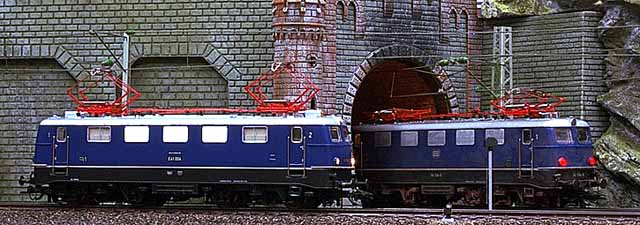

Roco has locomotives for the Maerklin AC-System. This so called AC models have other wheels to drive without derailings on M track. DC models with pivoting suspensions (bogie) have all axles driven. The same AC models have less one or two axles driven, because the screw of the pickup shoe stuck in the gearbox. Locomotives like 110 and 140 has three driven axles. The 141 and 181 has only two driven axles, one pivoting suspension (bogie) is total undriven, like Maerklin models. Roco AC models has a relay to switch the direction, newer ones has a decoder, but the driving quality is not so good as with 60902. Normally AC locos are more expensive, so it is often not be worth to rebuild such a loco. Besides one have to buy things like the direction relay and this is not needed later. The best way would be to buy a cheaper DC model. Often there are special bargins, too, or the are special versions of locomotives, which were never sold as AC models.
One day I saw a DC model of a E41 004 in the shop window for a special price, I took it at once. This blue E41 is a pre-series loco with side windows and I was looking for a long time for it. Later E41 has only exhaustors at the side for a better colling of the engines. Earlier there was also a AC model of the E41 004, but not so cheap.
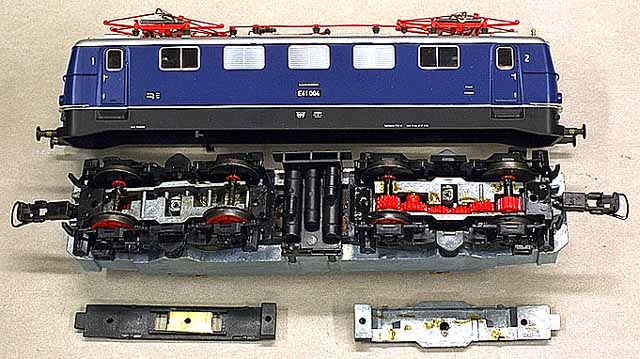
First the loco have to made ready for the point contacts of the track. I use the new K track series 22xx with square rails, so the DC wheels make no problems. Owner of older K tracks 21xx or M tracks should buy AC models, because it is expensive to change all wheels. The Roco model 43646 of the E41 004 has four driven axles. There are traction tires on one wheel of the first and the last axle. This is two less the AC model have. To fix a pickup shoe, one pivoting suspension (bogie) must be undriven. For reference I took a look at my rebuild, blue BR 141, which is an AC model. To have enough tractive, the axle with the one tire must be removed to the other pivoting suspension (bogie). First one have to untie the three screws und to remove the cap of the gearbox. The axle with the tire on the wheel, must be exchanged with an axel from the other bogie without tire. One bogie now have two axles each with a tire, but it is always on the left wheel. Not optimal, but better than nothing. This bogie is ready and can be closed.
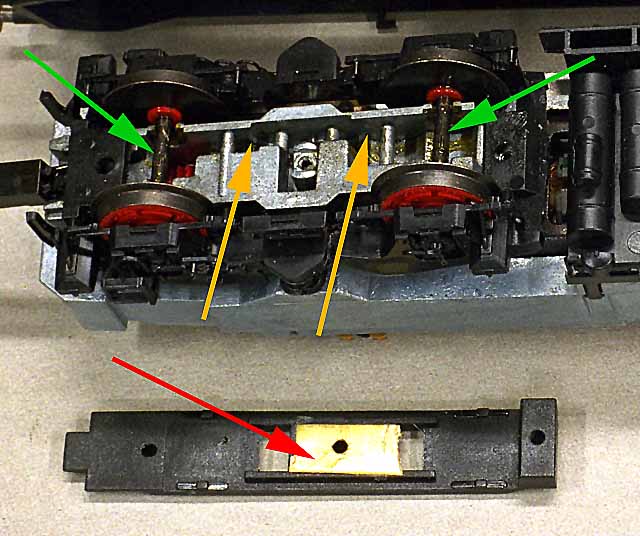
The other pivoting suspension (bogie) must be prepared for a pickup shoe. I removed the cardan and so the motor has not longer a connection to the gearbox. After that I opened the gearbox (not the snail screw) and removed all gearwheels (orange arrows). To fix a pickup shoe, an another gearboxcap is needed. Is has the number 93899. For other locos take a look at the colored AC parts at the replacement list. To fit the new gearboxcap, the gearwheels of the axles must be removed (green arrows). I do this with a sharp pair of pincers. Next the gearboxcap can be tighten, but it does not works with the old screw, because it is too long. This was the only problem at the E41 conversion. I took a brass sheet metal and drilled a 2 mm hole into it (red arrow). I glued the sheet onto the gearboxcap. It fitted between gearboxcap and gearbox. The screw of the Roco pickup shoe 40003 is too small, so I took a srew 75 61 00 from Maerklin. Normally this kind of srews tighten the Maerklin pickup shoe or the decoder holding device. It is not possible to tighten the screw, because the bogie needs space to move. With this conversion, the pickup shoe can not be fixed with a screw, it must be glued. This solution is the chaepest way. By using an "AC gearbox", the pickup shoe can be fixed with a screw, but it is more expensive.

The installation of the 60902 was the same as at the BR 141 and BR 140. To have a flickerfree light, the orange wire must be connected to the chassis. Before tighten the old Roco layer one must be shure that no other circuit has contact to the chassis. I connected the red-brown f1 wire to the taillights of driver´s stand 1 and the green-brown f2 wire to the other taillights.
Now came the first test drive. The loco drove, like as expected, silent and nearly jerkfree. Sometime a little tremble was to see and after start driving sometimes a whistling sound was to hear. The sound cames from the pulse frequency which makes some resonance vibrations inside the motor. This is irrelevant and does not damage motor or decoder. I tried to set the loco to speedlevel 10 = 100 km/h and hat to set the speed poti to maximum. In contrast to the AC model of the E41, the DC model has a slower gear ratio. The speed poti in my AC E41 is set to 50% for the same speed. In spite of the DC wheels it was possible to drive with max. speed on all turnouts and crossings without derailings. The tractive is lower, because it has only two tires. Beside the Roco tires are very slippery. It helps a litte to make them rough with sandpaper or to exchange them against tires from Maerklin. For pulling heavy train, it is the best solution to use an AC bogie (pivoting suspension) with 4 tires.
Some problems occurs with the light. The contact stripes were oxidized and three of the four bulbs were not lighted. Cleaning had no effect, often contact problems happened, so I soldered the wires direct onto the bulbs and removed the contact stripes. To change a bulb makes more work now, but I had never a contact problem again.
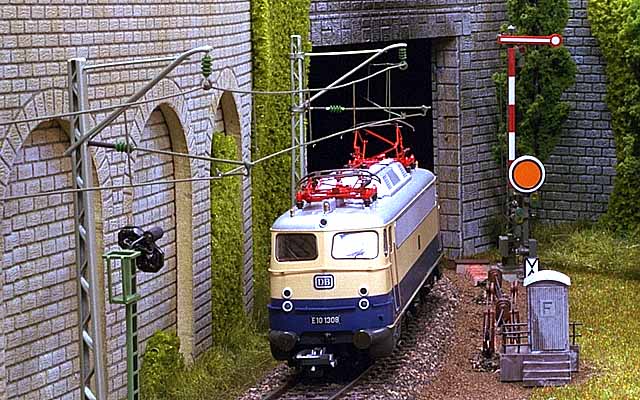
After this successful rebuilding, I bought another Roco loco in DC version. November 1999 the company Eurotrain presented a Roco special model 63699 of an E10, colored in blue and beige like the "Rheingold". In contrast to the Maerklin model it has the right exhaustors at the side, covered buffers, a front spoiler and a silver roof with a gutter around. Also the Marklin model 28503 has the wrong runnig gear from the 111 with snowplow. I was very happy to got a right model for my "Rheingold" train.
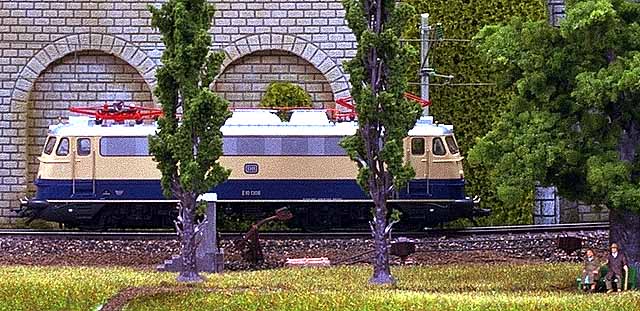
To install a pickup shoe is quite easy. Another gearbox plate with the number 10 06 22 is needed (red arrow). First the two screws at the underside of the pivoting suspension (bogie) must be removed. After this the gearbox can be opened. I removed the gearwheel of one axle with a sharp pair of pincers (green arrows). The photo shows on the right side the bogie before and on the left side after the rebuilding. The axle with the tire is unchanged. This loco has now three driven axles.
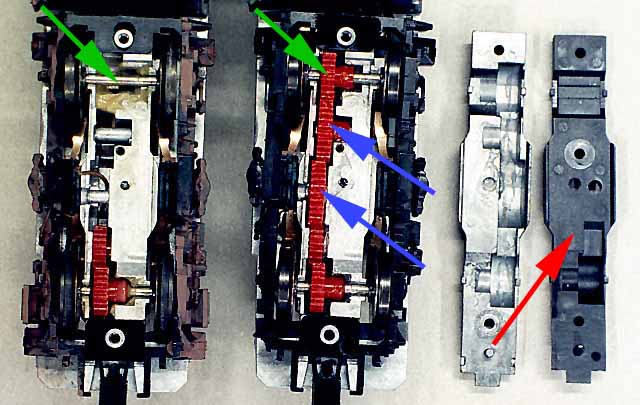
To fit the new gearbox plate, some gearwheels must be removed. To open the gearbox, first the plastik cover part of the worm box must be removed (orange arrow). Now ist is possible to split the gearbox and to take the two gearweels away (blue arrows). The assembly follows in reverse order. At last a Roco pickup shoe 40003 must be tighten and a wire soldered onto.
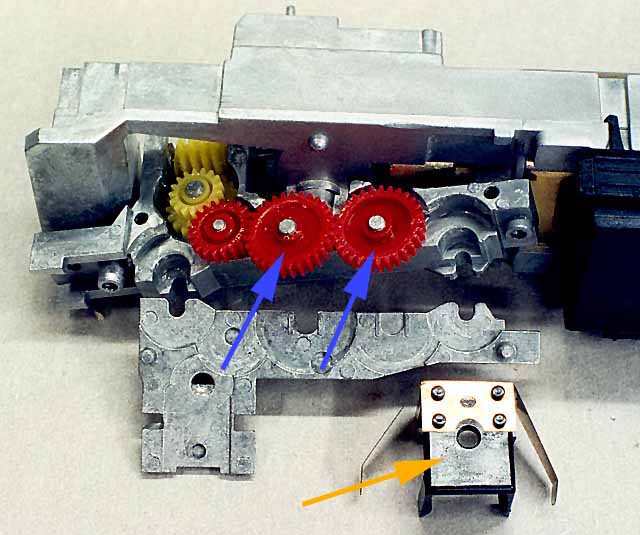
The traction of this loco is lower, too, because is has only two tires. It is possible to use tires from Maerlin, they are not so slippery, or to buy two AC-axles with four tires. All my locos have a second pickup shoe to avoid contact problems on turnouts at low speed. I use the catenary as a backup power line for my electrical locos. Also it is possible to build a second pickup shoe to the Roco locos 110, 140 ect. One have to rebuild both bogies like described. After this only two axles were driven, one in each bogie, but if they have tires, the loco has enough traction power.